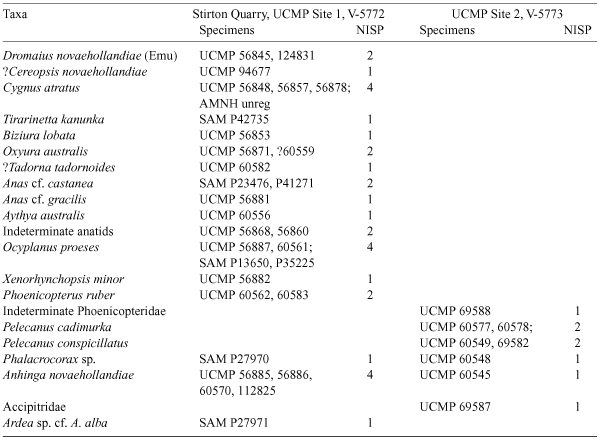Pliocene waterfowl (Aves : Anseriformes) from South Australia and a new genus and species
Trevor H. WorthyDarling Building, DP 418, Department of Earth and Environmental Sciences, The University of Adelaide, Adelaide, SA 5005, Australia. Email: trevor.worthy@adelaide.edu.au
Emu 108(2) 153-165 https://doi.org/10.1071/MU07063
Submitted: 18 October 2007 Accepted: 6 May 2008 Published: 11 June 2008
Abstract
The occurrences of fossil bones of waterfowl (Aves : Anseriformes) in Pliocene faunas from the Lake Eyre Basin are described. Nine modern taxa are present in either the Kanunka or the Toolapinna Faunas from the Tirari Formation as follows: Anseranas semipalmata (Magpie Goose), Cereopsis novaehollandiae (Cape Barren Goose), Cygnus atratus (Black Swan), Tadorna tadornoides (Australian Shelduck), Biziura lobata (Musk Duck), Oxyura australis (Blue-billed Duck), Anas cf. A. castanea (Chestnut Teal), A. cf. A. gracilis (Grey Teal) and Aythya australis (Hardhead). A new genus and species of oxyurine, Tirarinetta kanunka, gen. et sp. nov. is described from the Kanunka Fauna on the basis of a humerus.
Acknowledgements
I thank Richard Tedford and Rod Wells for the fieldwork carried out over many years that resulted in the collections containing the fossils described herein, and particularly for their making it possible for me to work on the Warburton sites in 2006 with them. The goodwill of the owners of Kalamurina Station and the manager, Nathan Keogh, enabled access to the Warburton sites. Many other people helped on these field trips but in 2006 I thank Aaron Camens for his willingness to chase small bird bones when diprotodontids were calling. I am also indebted to the University of Adelaide for supporting this fieldwork by its provision of a suitable expedition vehicle. This study would not have been possible without the cooperation of several museum collection managers and curators to whom I am particularly indebted for access to either fossils or reference material: Walter Boles, AM; Carl Mehling, AMNH; Robert Palmer, ANWC; Alan Tennyson and Gillian Stone, NMNZ; Rory O’Brien, David Pickering and Tom Rich, MV; Philippa Horton and Dennis Rice, SAM; Dirk Megirian, NTM; Rod Wells, FU; Kristen Spring and Heather Janetzki, QM; and Storrs Olson, James Dean, and Christopher Milensky, USNM. I thank Neville Pledge (SAM) and Rod Wells (FU) for readily providing data on fossil sites from which some of the specimens were derived, and Walter Boles and two anonymous referees for comments on earlier drafts of this paper.
Alley, N. F. (1998). Cainozoic stratigraphy, palaeoenvironments and geological evolution of the Lake Eyre Basin. Palaeogeography, Palaeoclimatology, Palaeoecology 144, 239–263.
| Crossref | GoogleScholarGoogle Scholar |
Baird, R. F. , and Vickers-Rich, P. (1998). Palaelodus (Aves : Palaelodidae) from the Middle to Late Cainozoic of Australia. Alcheringa 22, 135–151.
Boles, W. E. , and Ivison, T. J. (1999). A new genus of the dwarf megapode (Galliformes : Megapodiidae) from the late Oligocene of Central Australia. Smithsonian Contributions to Paleobiology 89, 199–206.
Howard, H. (1929). The avifauna of Emeryville Shellmound. University of California Publications in Zoology 32(2), 301–394.
Livezey, B. C. (1986). A phylogenetic analysis of Recent anseriform genera using morphological characters. Auk 105, 681–698.
Maroulis, J. C. , Nanson, G. C. , Price, D. M. , and Pietsch, T. (2007). Aeolian-fluvial interaction and climate change: source-bordering dune development over the past ~100 ka on Cooper Creek, central Australia. Quaternary Science Reviews 26, 386–404.
| Crossref | GoogleScholarGoogle Scholar |
Rich, P. V. , and van Tets, G. F. (1981). The fossil pelicans of Australasia. Records of the South Australian Museum 18, 235–264.
Rich, P. V. , van Tets, G. F. , Rich, T. H. V. , and McEvey, A. R. (1987). The Pliocene and Quaternary flamingoes of Australia. Memoirs of the Queensland Museum 25, 207–225.
Richman, S. E. , and Lovvorn, J. R. (2008). Costs of diving by wing and foot propulsion in a sea duck, the white-winged scoter. Journal of Comparative Physiology. B: Biochemical, Systemic, and Environmental Physiology 178, 321–332.
| Crossref | GoogleScholarGoogle Scholar |
Tedford, R. H. , Wells, R. T. , and Barghoorn, S. F. (1992). Tirari Formation and contained faunas, Pliocene of the Lake Eyre Basin, South Australia. The Beagle, Records of the Northern Territory Museum of Arts and Sciences 9, 173–194.
Woodburne, M. O. , Macfadden, B. J. , Case, J. A. , Springer, M. S. , Pledge, N. S. , Power, J. D. , Woodburne, J. M. , and Springer, K. B. (1994). Land mammal biostratigraphy and magnetostratigraphy of the Etadunna Formation (Late Oligocene) of South Australia. Journal of Vertebrate Paleontology 13, 483–515.

Woolfenden, G. E. (1961). Postcranial osteology of the waterfowl. Bulletin of the Florida State Museum, Biological Sciences 6, 1–129.

Worthy, T. H. (1995). Description of some post-cranial bones of Malacorhynchus scarletti, a large extinct pink-eared duck from New Zealand. Emu 95, 13–22.

Worthy, T. H. (2004). The Holocene fossil waterfowl fauna of Lake Poukawa, North Island, New Zealand. Tuhinga: Records of the Museum of New Zealand Te Papa Tongarewa 15, 77–120.

Worthy, T. H. (in press). Descriptions and phylogenetic relationships of two new genera and four new species of Oligo-Miocene waterfowl (Aves:Anatidae) from Australia. Zoological Journal of the Linnean Society ,

Worthy, T. H. , and Gill, B. J. (2002). New distributional records of the extinct New Zealand duck Malacorhynchus scarletti (Anatidae). Records of the Auckland Museum 39, 49–52.

Worthy, T. H. , and Lee, M. S. Y. (2008). Affinities of Miocene waterfowl (Anatidae: Manuherikia, Dunstanetta and Miotadorna) from the St Bathans Fauna, New Zealand. Palaeontology 51, 677–708.
| Crossref | GoogleScholarGoogle Scholar |


|


